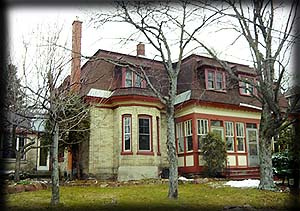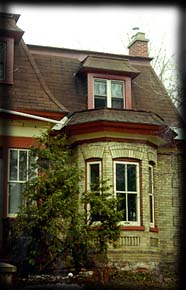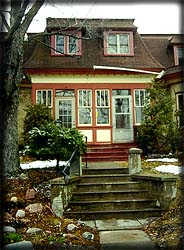|
|
34 HERRICK STREET, SAULT STE. MARIE DESCRIPTION
To the south of the main house was constructed a single storey extension presumed to have been a summer kitchen. The 1901 revision to the fire insurance plan of the City indicates that at that time the extension also projected to the north running parallel to the lane. This no longer exists and may have contained stabling or have acted as a coach house.
The brick has been well detailed particularly at the comers where quoins have been formed and under the bay windows with inset panels of soldier bricks with their edges set out at 45 degrees. The basement of the house has been constructed of sandstone rubble and the first three courses of brick above are projected out from the continuing face of the brick above returning to meet this face with a course of a specially shaped 45 degree angled brick. The brick has all been laid in stretcher bond. Two large bay windows with double hung wood sash windows are located symmetrically on either side of the central frontispiece which contains the main entrance porch. The lintels over the bay windows are arched and formed of a soldier course and a half of brick.
Second floor windows are all projected dormers from the mansard roof and each of the four located on the south elevation (two in the projecting central section over the porch and one over each bay window) are roofed individually in miniature replications of the main roof. The windows themselves are double hung wood sash, a pair to each dormer. The mansard roof originally of cedar shingles is concave and flares out to meet the cornice. An early black and white photograph indicates a horizontal band of scalloped shingles located midway up the roof, the width of the band being approximately six courses and of a lighter colour than the remainder of the roof. The house was originally equipped with three brick chimneys none of which exist today although it appears that the most recent chimney constructed on the west elevation is in the same location as one of the originals. The original chimneys are slender but with corbelled brick caps. The symmetry of the house design has been reflected in the early landscaping. A walkway (possibly of wood) was constructed from the base of the porch steps down to another set of steps set in a stone retaining wall leading to another path to the street and four maples have been planted symmetrically on each side of the main entrance path, two on the upper level and two smaller on the lower levels. Low planting (possibly alpine currant) was also planted at the top of the retaining wall on either side of the steps. A virginin creeper is also seen growing on the front east bay window. At some stage in the history of the house, a demising wall was constructed through the middle and the front porch rebuilt to accommodate two front doors and the resulting building has remained as two semi-detached houses to this day. The date of the division is not known but it is clearly shown on the 1901 revision of the 1899 Insurance Plan. The change to the front porch unfortunately removed the stonefront original with its large areas of glazing although the replacement was constructed with reasonable compliment to the remainder of the house. The mansard roof is now asphalt shingled although the original cedar shingles can still be seen on the exposed side walls of the dormer windows. Two of the originally planted trees still exist at the front of the house although the retaining wall has long since disappeared and the lawns are banked down to the sidewalk. SIGNIFICANCE The term "Second Empire" is derived from a style of architecture popular in France during the reign of Napoleon III. This style was transplanted to the United States and Canada by trade journals and pattern books. The style was extremely popular in Canada in the 1820's and 1880's, fully blown as public building and also in a toned down vernacular formed in residential (and often town house row) construction. The following description of the Second Empire (1860-1900) is taken from John Blumenson, Fitz Henry and Whiteside 1990 Ontario Architecture: " In vernacular tradition, often the most recognizable stylistic feature is the mansard roof . The profile of the roof may be straight, convex, concave or a combination of the three, covered with multicolored slates and punctuated by dormers of various shapes and sizes . The formal appearance of the overall composition may be heightened by a projecting central frontispiece that at times continues upward, forming a distinct tower, when the projection occurs at the ends or corners of a building, as in the Toronto post office, this feature may be referred to as a pavilion. When the tower is placed off-centre, the asymmetrical balance of the facade creates a picturesque quality not unlike nineteenth century building practices, windows are large, with only one or two panes or lights per sash, and may be round, segmental or at times pointed; are most often framed with enriched surrounds and mouldings, The cornice is often embellished in fashion similar to the Italianate, with brackets, large blocks and a decorated frieze. Though stone is preferred, brick is often used, but regardless of the material, the exterior is invariably enriched with Classical mouldings and detail around door and window apertures, as well as corners, where heavy rustication or quoins are employed. The entrance is often a double door, with glazed upper panels having coloured or etched glass. Large sweeping porches or wraparound verandas characteristic of the Queen Anne style are not popular in the informal asymmetrical examples, but may be seen on the informal, asymmetrically balanced towered versions." Sault Ste. Marie has few mansarded roof properties remaining. The Administration building at the Sault Ste. Marie Canal (1895) and the Wellington Square Townhouses (1913 ) are the significant examples. 34 - 36 Herrick Street may well demonstrate however some unique characteristics not found in the other properties.
|




